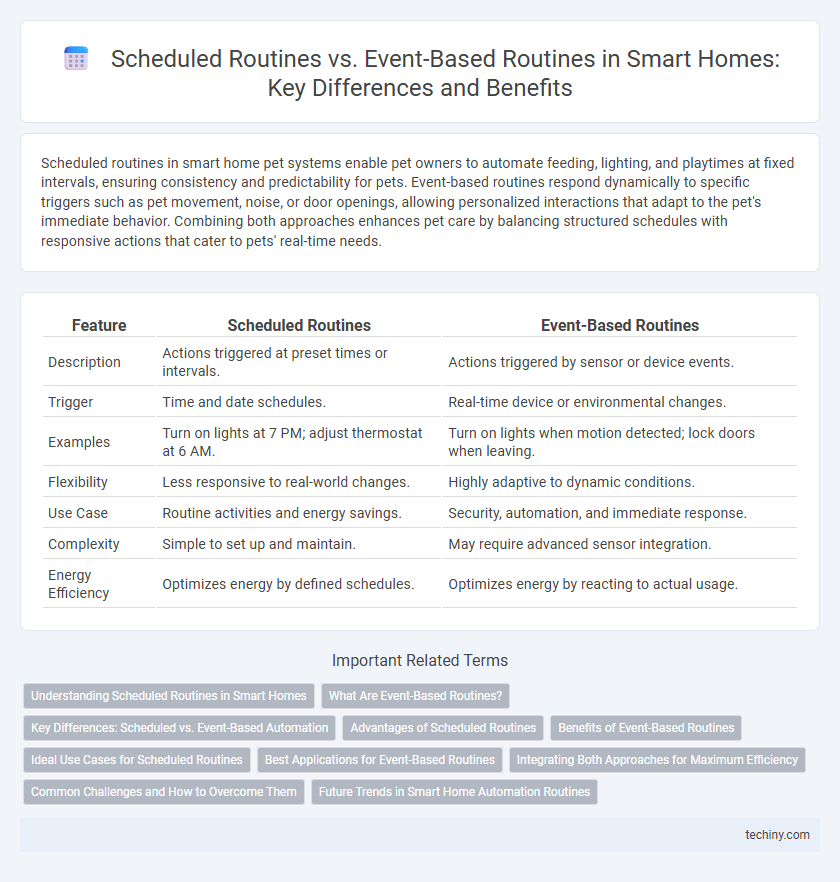Scheduled routines in smart home pet systems enable pet owners to automate feeding, lighting, and playtimes at fixed intervals, ensuring consistency and predictability for pets. Event-based routines respond dynamically to specific triggers such as pet movement, noise, or door openings, allowing personalized interactions that adapt to the pet's immediate behavior. Combining both approaches enhances pet care by balancing structured schedules with responsive actions that cater to pets' real-time needs.
Table of Comparison
| Feature | Scheduled Routines | Event-Based Routines |
|---|---|---|
| Description | Actions triggered at preset times or intervals. | Actions triggered by sensor or device events. |
| Trigger | Time and date schedules. | Real-time device or environmental changes. |
| Examples | Turn on lights at 7 PM; adjust thermostat at 6 AM. | Turn on lights when motion detected; lock doors when leaving. |
| Flexibility | Less responsive to real-world changes. | Highly adaptive to dynamic conditions. |
| Use Case | Routine activities and energy savings. | Security, automation, and immediate response. |
| Complexity | Simple to set up and maintain. | May require advanced sensor integration. |
| Energy Efficiency | Optimizes energy by defined schedules. | Optimizes energy by reacting to actual usage. |
Understanding Scheduled Routines in Smart Homes
Scheduled routines in smart homes automate tasks based on specific times or dates, such as turning lights on at sunset or adjusting thermostats at bedtime, enhancing energy efficiency and convenience. These routines leverage built-in timers and calendars within smart devices to ensure consistent daily habits without manual input. Understanding scheduled routines allows homeowners to optimize their smart home ecosystem by predefining actions that align with their lifestyle patterns and preferences.
What Are Event-Based Routines?
Event-based routines in smart home systems activate specific actions in response to defined triggers, such as motion detection, door opening, or environmental changes like temperature shifts. Unlike scheduled routines that operate on fixed time intervals, event-based routines offer dynamic automation tailored to real-time conditions, enhancing security and energy efficiency. These routines leverage sensors and connected devices to create responsive environments that adjust instantly to user activity or external events.
Key Differences: Scheduled vs. Event-Based Automation
Scheduled routines trigger smart home actions at pre-set times, ensuring consistent automation based on clock or calendar events, ideal for daily tasks like lighting or thermostat adjustments. Event-based routines activate in response to specific sensors or device actions, such as motion detection or door opening, enabling adaptive and real-time control for security or energy management. The key difference lies in scheduled routines relying on fixed timing, while event-based routines depend on dynamic sensor input for automation.
Advantages of Scheduled Routines
Scheduled routines in smart homes offer consistent automation by activating devices at predetermined times, ensuring daily tasks like lighting and climate control operate seamlessly without manual input. This predictability enhances energy efficiency and security by maintaining regular patterns, such as automatically turning off appliances during peak hours. Homeowners benefit from reduced cognitive load and increased convenience through reliable, time-based smart device management.
Benefits of Event-Based Routines
Event-based routines in smart homes enhance automation by triggering actions based on real-time events like motion detection or door openings, improving responsiveness and security. They enable dynamic adjustments to lighting, climate, and appliances without manual input, maximizing energy efficiency and user convenience. This adaptability creates a personalized living environment that reacts instantly to occupants' behavior and external conditions.
Ideal Use Cases for Scheduled Routines
Scheduled routines in smart homes are ideal for automating daily activities such as turning lights on at sunset, adjusting thermostats before waking, or activating security systems at bedtime. These routines optimize energy efficiency and enhance convenience by executing predefined actions at specific times without user intervention. Consistent time-based automation ensures predictability and reliability in managing household environments.
Best Applications for Event-Based Routines
Event-based routines excel in dynamic smart home environments where actions respond instantly to specific triggers like motion detection, door opening, or voice commands. Ideal applications include security systems that activate alarms or lighting upon detecting unauthorized entry and energy-saving setups that adjust thermostats when no one is home. These routines enhance automation responsiveness, ensuring efficient, real-time adjustments aligned with daily activities and user behaviors.
Integrating Both Approaches for Maximum Efficiency
Integrating scheduled routines with event-based routines enhances smart home efficiency by combining time-driven automation with real-time environmental triggers. Scheduled routines automate predictable tasks like adjusting thermostats at set times, while event-based routines respond dynamically to sensor inputs such as motion detection or door opening. Leveraging both approaches ensures energy savings, improved security, and personalized comfort tailored to daily habits and unexpected changes.
Common Challenges and How to Overcome Them
Scheduled routines in smart homes often face challenges like rigid timing and lack of adaptability to real-time conditions, limiting their efficiency. Event-based routines may struggle with sensor inaccuracies or connectivity issues, causing unintended triggers or missed actions. Overcoming these challenges involves integrating adaptive algorithms, reliable sensors, and robust network protocols to ensure seamless, responsive automation.
Future Trends in Smart Home Automation Routines
Scheduled routines in smart home automation execute tasks at predetermined times, enhancing daily convenience by automating lighting, temperature, and security settings. Event-based routines trigger actions in response to sensors or user behaviors, enabling dynamic adaptation to environmental changes and occupant presence. Future trends emphasize AI-driven predictive analytics and machine learning to create hybrid routines that combine scheduled and event-based triggers for more personalized, efficient, and energy-saving smart home experiences.
Scheduled routines vs Event-based routines Infographic

 techiny.com
techiny.com